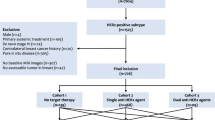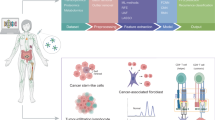Abstract
Most studies on breast cancer metastasis have been performed using triple-negative breast cancer cells; thus, subtype-dependent metastatic ability of breast cancer is poorly understood. In this research, we performed intravenous injection (IVI) and intra-caudal arterial injections using nine human epidermal growth factor receptor-2 (HER2)-positive breast cancer cell lines for evaluating their metastatic abilities. Our results showed that MDA-MB-453, UACC-893, and HCC-202 had strong bone metastatic abilities, whereas HCC-2218 and HCC-1419 did not show bone metastasis. HER2-positive cell lines could hardly metastasize to the lung through IVI. From the genomic analysis, gene signatures were extracted according to the breast cancer subtypes and their metastatic preferences. The UACC-893 cell line was identified as a useful model for the metastasis study of HER2-positive breast cancer. Combined with our previous result on brain metastasis ability, we provide a characteristic metastasis profile of HER2-positive breast cancer cell lines in this study.






Similar content being viewed by others
Data availability
The data of presented study are available from the corresponding author upon reasonable request.
References
Jemal A, Bray FMM et al (2011) Global cancer statistics. CA Cancer J Clin 61:69–90. https://doi.org/10.3322/caac.20107
Liu K, Newbury PA, Glicksberg BS et al (2019) Evaluating cell lines as models for metastatic breast cancer through integrative analysis of genomic data. Nat Commun. https://doi.org/10.1038/s41467-019-10148-6
Jin X, Demere Z, Nair K et al (2020) A metastasis map of human cancer cell lines. Nature 588:331–336. https://doi.org/10.1038/s41586-020-2969-2
Moasser MM (2007) Targeting the function of the HER2 oncogene in human cancer therapeutics. Oncogene 26:6577–6592. https://doi.org/10.1038/sj.onc.1210478
Gong Y, Liu YR, Ji P et al (2017) Impact of molecular subtypes on metastatic breast cancer patients: a SEER population-based study. Sci Rep. https://doi.org/10.1038/srep45411
Jiang H, Rugo HS (2015) Human epidermal growth factor receptor 2 positive (HER2+) metastatic breast cancer: how the latest results are improving therapeutic options. Ther Adv Med Oncol 7:321–339. https://doi.org/10.1177/1758834015599389
Asif HM, Sultana S, Ahmed S et al (2016) HER-2 positive breast cancer—A mini-review. Asian Pacific J Cancer Prev 17:1609–1615. https://doi.org/10.7314/APJCP.2016.17.4.1609
Nakayama J, Han Y, Kuroiwa Y et al (2021) The in vivo selection method in breast cancer metastasis. Int J Mol Sci 22:1–19. https://doi.org/10.3390/ijms22041886
Kuroiwa Y, Nakayama J, Adachi C et al (2020) Proliferative classification of intracranially injected HER2-positive breast cancer cell lines. Cancers (Basel). https://doi.org/10.3390/cancers12071811
Kuchimaru T, Kataoka N, Nakagawa K et al (2018) A reliable murine model of bone metastasis by injecting cancer cells through caudal arteries. Nat Commun. https://doi.org/10.1038/s41467-018-05366-3
Han Y, Nakayama J, Hayashi Y et al (2020) Establishment and characterization of highly osteolytic luminal breast cancer cell lines by intracaudal arterial injection. Genes Cells 25:111–123. https://doi.org/10.1111/gtc.12743
Nakayama J, Ito E, Fujimoto J et al (2017) Comparative analysis of gene regulatory networks of highly metastatic breast cancer cells established by orthotopic transplantation and intra-circulation injection. Int J Oncol 50:497–504. https://doi.org/10.3892/ijo.2016.3809
Ito E, Honma R, Yanagisawa Y et al (2007) Novel clusters of highly expressed genes accompany genomic amplification in breast cancers. FEBS Lett 581:3909–3914. https://doi.org/10.1016/j.febslet.2007.07.016
Zhou Y, Zhou B, Pache L et al (2019) Metascape provides a biologist-oriented resource for the analysis of systems-level datasets. Nat Commun. https://doi.org/10.1038/s41467-019-09234-6
Murakami A, Maekawa M, Kawai K et al (2019) Cullin-3 / KCTD10 E3 complex is essential for Rac1 activation through RhoB degradation in human epidermal growth factor receptor 2- positive breast cancer cells. Cancer Sci 110:650–661. https://doi.org/10.1111/cas.13899
Nishiyama K, Maekawa M, Nakagita T et al (2021) CNKSR1 serves as a scaffold to activate an EGFR phosphatase via exclusive interaction with RhoB-GTP. Life Sci Alliance 4:e202101095
Goldenberg DM, Stein R, Sharkey RM (2018) The emergence of trophoblast cell-surface antigen 2 (TROP-2) as a novel cancer target. Oncotarget 9:28989–29006
Dalotto-Moreno T, Croci DO, Cerliani JP et al (2013) Targeting galectin-1 overcomes breast cancer-associated immunosuppression and prevents metastatic disease. Cancer Res 73:1107–1117. https://doi.org/10.1158/0008-5472.CAN-12-2418
Escárcega RO, Fuentes-Alexandro S, García-Carrasco M et al (2007) The transcription factor nuclear factor-kappa b and cancer. Clin Oncol 19:154–161. https://doi.org/10.1016/j.clon.2006.11.013
Li Q, Lai Q, He C et al (2019) RUNX1 promotes tumour metastasis by activating the Wnt/β-catenin signalling pathway and EMT in colorectal cancer. J Exp Clin Cancer Res. https://doi.org/10.1186/s13046-019-1330-9
Cleris D, Fina C (2019) The detection and morphological analysis of circulating tumor and host cells in breast cancer xenograft models. Cells 8:683. https://doi.org/10.3390/cells8070683
Chen F, Liu X, Bai J et al (2016) The emerging role of RUNX3 in cancer metastasis (Review). Oncol Rep 35:1227–1236. https://doi.org/10.3892/or.2015.4515
Manandhar S, Lee YM (2018) Emerging role of RUNX3 in the regulation of tumor microenvironment. BMB Rep 51:174–181. https://doi.org/10.5483/BMBRep.2018.51.4.033
Park J, Kim HJ, Kim KR et al (2017) Loss of RUNX3 expression inhibits bone invasion of oral squamous cell carcinoma. Oncotarget 8:9079–9092
Barkovskaya A, Buffone A, Žídek M, Weaver VM (2020) Proteoglycans as mediators of cancer tissue mechanics. Front Cell Dev Biol. https://doi.org/10.3389/fcell.2020.569377
Fjeldstad K, Kolset SO (2005) Decreasing the metastatic potential in cancers–targeting the heparan sulfate proteoglycans. Curr Drug Targets 6:665–682. https://doi.org/10.2174/1389450054863662
Quinn JJ, Jones MG, Okimoto RA et al (2021) Single-cell lineages reveal the rates, routes, and drivers of metastasis in cancer xenografts. Science 371:1–21
Chen Y, Qian B, Sun X et al (2021) Sox9/INHBB axis-mediated crosstalk between the hepatoma and hepatic stellate cells promotes the metastasis of hepatocellular carcinoma. Cancer Lett 499:243–254. https://doi.org/10.1016/j.canlet.2020.11.025
Chen X, Cao Q, Liao R et al (2019) Loss of ABAT-mediated GABAergic system promotes basal-like breast cancer progression by activating Ca2+-NFAT1 axis. Theranostics 9:34–47. https://doi.org/10.7150/thno.29407
Jansen MPHM, Sas L, Sieuwerts AM et al (2015) Decreased expression of ABAT and STC2 hallmarks ER-positive inflammatory breast cancer and endocrine therapy resistance in advanced disease. Mol Oncol 9:1218–1233. https://doi.org/10.1016/j.molonc.2015.02.006
Acknowledgements
We thank Ms Yuka Kuroiwa and laboratory members for the meaningful comments and discussion.
Funding
This study was supported by JSPS KAKENHI (Grant No. 18K16269: Grant-in-Aid for Early-Career Scientist to JN; Grant No. 20J01794, Grant-in-Aid for JSPS fellows to JN; Grant No. 20J23297, Grant-in-Aid for JSPS fellows to YH) and partially supported by the grants for translational research programs from Fukushima Prefecture (SW and KS).
Author information
Authors and Affiliations
Contributions
YH and KA performed the in vivo experiments. YH preformed the bioinformatics analyses. SW and KS interpreted the data. YH, KA, and JN wrote the manuscript. JN conceived and designed the study. All the authors reviewed and edited the manuscript.
Corresponding author
Ethics declarations
Conflict of interest
The authors declare that they have no competing interests.
Ethical approval
The animal experiments were conducted under the approval of the ethics committee of Waseda University (2020-A067, 2021-A074).
Additional information
Publisher's Note
Springer Nature remains neutral with regard to jurisdictional claims in published maps and institutional affiliations.
Supplementary Information
Below is the link to the electronic supplementary material.
10585_2022_10150_MOESM1_ESM.tif
Supplementary Fig. S1 Evaluation of bone metastasis potential of HER2-positive cell lines. The bone metastatic tumors of all transplanted mice (n = 4) at week 8 were observed and summarized. (a) High bone metastatic potential group. (b) Non-high bone metastatic potential group. One of the mice transplanted with BT-474 died during the observation. The mouse indicated with a yellow star exhibited metastatic tumors other than bone tumors. (c) Average tumor size ± standard error of the mean at week 8 for each cell line (TIF 111426 kb)
10585_2022_10150_MOESM2_ESM.tif
Supplementary Fig. S2 Transplantation of the HER2-positive cell lines via IVI. UACC-893, HCC-202, MDA-MB-453, ZR-75–1, HCC-1419, HCC-2218, BT-474, MDA-MB-361, and UACC-812 cells were intravenously injected in the NOD-SCID mice (MDA-MB-453, n = 9; UACC-893, n = 7; HCC-202, n = 5; MDA-MB-361, n = 3; others, n = 4). (a) Lung metastasis was quantified by measuring bioluminescence every week. Left: Bioluminescence on week 1. Right: Bioluminescence on week 8. (b) The lungs were removed from each mouse after the 8-week measurement, and luminescence from the lung was detected using ex vivo BLI (TIF 93701 kb)
Rights and permissions
About this article
Cite this article
Han, Y., Azuma, K., Watanabe, S. et al. Metastatic profiling of HER2-positive breast cancer cell lines in xenograft models. Clin Exp Metastasis 39, 467–477 (2022). https://doi.org/10.1007/s10585-022-10150-1
Received:
Accepted:
Published:
Issue Date:
DOI: https://doi.org/10.1007/s10585-022-10150-1




